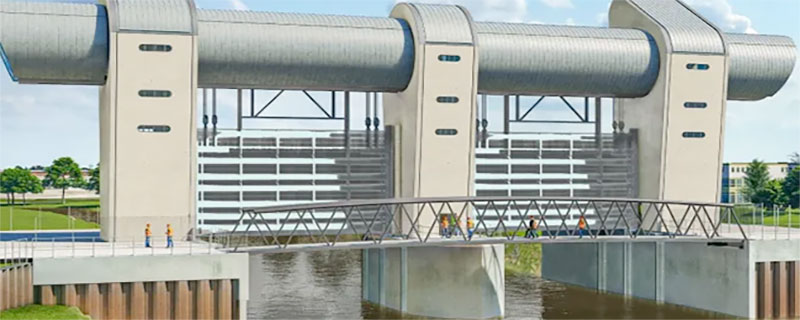The Bridgewater Tidal Barrier
Illustration of the completed barrier
The £249M Bridgwater tidal barrier project has reached a milestone with the arrival of a jack up barge that will enable the construction of a cofferdam and piling.
The Bridgwater tidal barrier project in Somerset will be one of the largest flood defence schemes in the UK.
The project comprises a tidal surge barrier across the River Parrett between Express Park and Chilton Trinity and improved flood defences downstream of the barrier. This will involve increasing the height of the existing riverside flood banks in some areas.

The arrival of a jack up barge in Bridgewater on 13 March will enable the construction of the cofferdam, an enclosure pumped dry to allow work below the water level, and bearing piles for the barrier’s foundations.
Known as Haven Sea Seven, the 30.5m long and 18.3m wide jack up barge was delivered to the site from Liverpool where it was dispatched on 27 February. Enroute, the barge docked at Barry Port where a 300t crane was loaded, before continuing its journey to Bridgwater.
The barrier is being developed by the Environment Agency (EA) in partnership with Somerset Council and supported by the Somerset Rivers Authority (SRA) and the Local Enterprise Partnership (LEP).
Atkins Réalis was commissioned by the EA to undertake the detailed design for the barrier, while Kier is the contractor.
Kier has already installed pre-cast concrete piles and a load bearing working platform on the left bank at Express Park to support the large plant required to build the barrier.
On the right bank side of the river at Chilton Trinity, piling works to upgrade the outfall structure at Pims Clyce were completed in February this year. A new sheet piled retaining wall has been installed, enabling the crest level to be raised.
Kier will now carry out bulk filling and installing tie rods and capping beams to complete the upgrades require.
Enabling works started on the barrier and downstream defences in 2023.
Commenting on the delivery of the jack up barge, EA flood and coastal risk manager for Wessex, Rachel Burden, said that it was a “big step” towards delivering the project.
Kier’s natural resources, nuclear and networks, operations director for the environment agency framework, Philip Ramsay, said: “It’s brilliant to see the progress on both sides of the River Parrett including the arrival of the jack up barge.”
Set to be operational by 2027, the Bridgwater tidal barrier will better protect 11,300 homes and 1,500 businesses from tidal flooding in Bridgwater and nearby communities and provide £2bn in benefits to the local area.
The scheme comprises the tidal barrier; an operational site with a control building and store; downstream flood banks at Chilton Trinity, Pawlett and Combwich; and 12 upstream sites with improved fish and eel passage.
The barrier will feature two “vertical lift” gates to prevent water from flowing upstream during very high tides.
The full business case for the Bridgwater tidal barrier was approved last autumn.
The project has been beset by challenges and rising costs in recent years. When it was greenlit in March 2022, it was costed at around £100M. In late 2022, work was paused due to the discovery of asbestos.
By late 2023 the EA’s Wessex regional flood and coastal committee set the cost at £249M due to rises in risk allowance, inflation and design and construction costs.
Source: Ground Engineering









Leave a Reply
Want to join the discussion?Feel free to contribute!